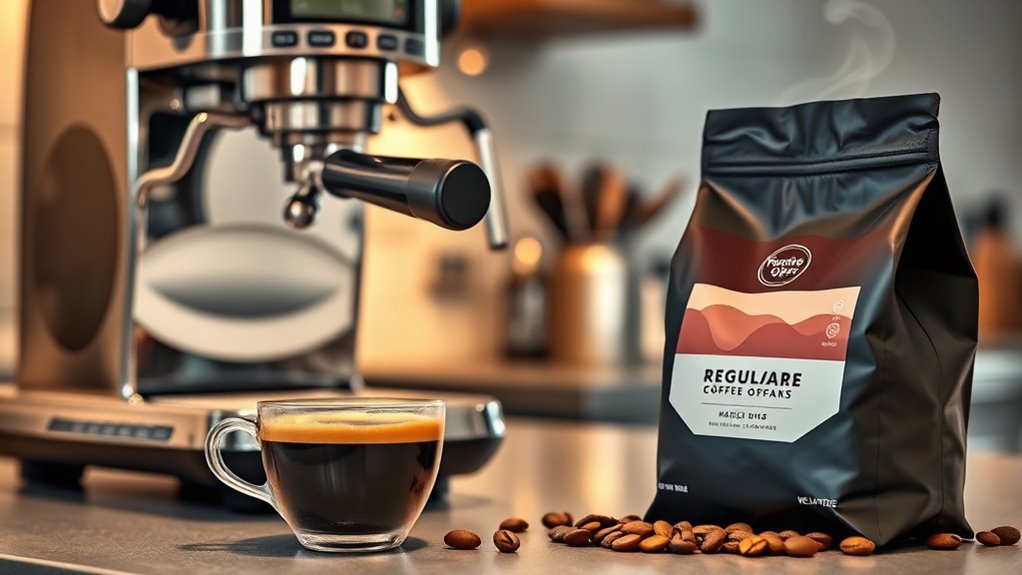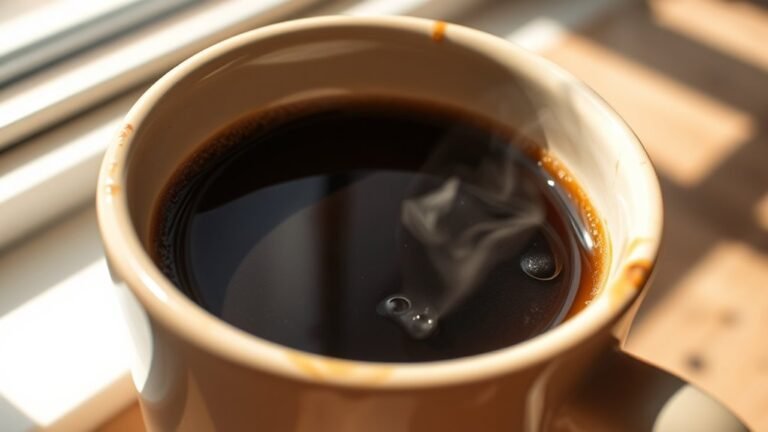Can You Use Regular Coffee in Espresso Machine
You can use regular coffee in an espresso machine, but expect some trade-offs in flavor and extraction quality. Regular coffee generally uses coarser grounds, which may lead to under-extraction resulting in a weak taste. For best results, fine-tuning grind size and adjusting brewing parameters are essential. While it’s feasible, traditional espresso’s richness and complexity may be compromised. By exploring further, you’ll uncover valuable insights for achieving the perfect espresso experience.
Understanding the Difference Between Regular Coffee and Espresso
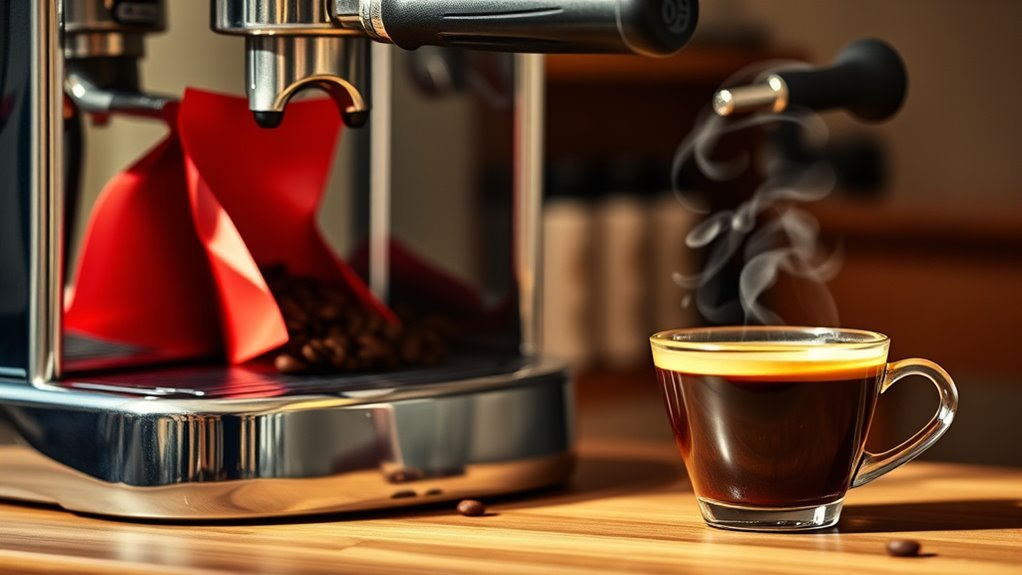
While you might think of coffee as a singular beverage, there’s a significant distinction between regular coffee and espresso that affects their preparation and flavor profiles. Regular coffee typically involves coarser grounds and various brewing methods, like drip or French press, which extract flavors over a longer time. In contrast, espresso uses finely ground coffee and high pressure, resulting in a concentrated shot with a rich crema on top. The coffee types used for espresso often prioritize bold flavors and low acidity. This difference in brewing methods means that espresso captures a unique intensity, making it distinct from regular coffee. Understanding these nuances empowers you to appreciate each beverage’s unique characteristics and choose your method accordingly.
How Espresso Machines Work
Espresso machines operate through a combination of pressure, temperature, and finely ground coffee to create a concentrated shot of espresso. The essential espresso machine components include the boiler, pump, and portafilter. The boiler heats water to an ideal temperature, while the pump generates high pressure, usually around 9 bars, important for extracting flavors and oils from the coffee grounds. Understanding coffee brewing basics is significant; the grind size, typically finer for espresso, allows for maximum flavor extraction within a short brewing time. As water flows through the compacted coffee grounds, it creates that rich, bold flavor profile characteristic of espresso. Mastering these components and principles helps you appreciate the artistry behind each shot you brew.
Potential Outcomes of Using Regular Coffee
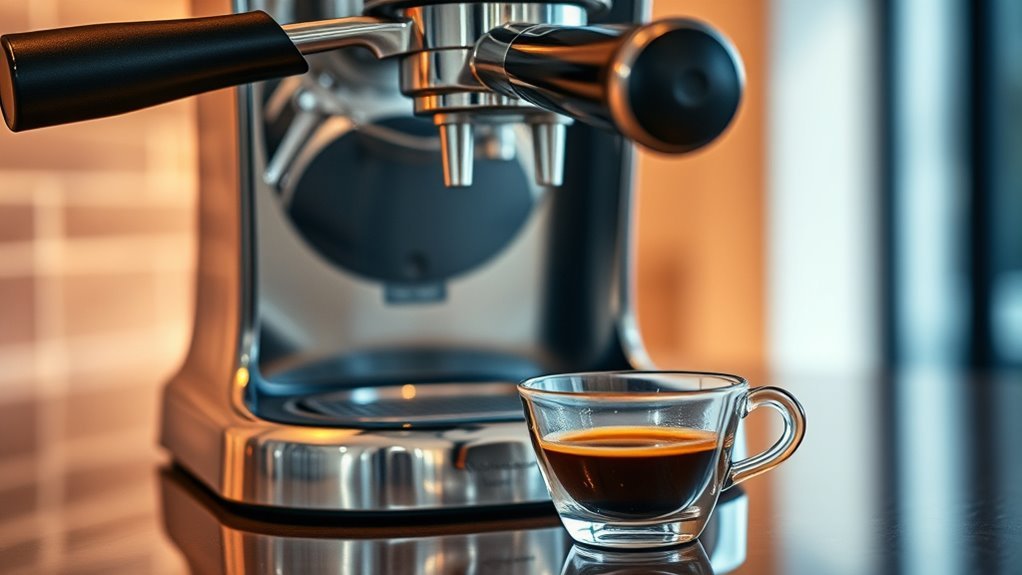
Using regular coffee in an espresso machine can lead to distinct flavor profile differences that may not meet your expectations. Additionally, the extraction process can present challenges, as regular coffee may not be ground finely enough to achieve the desired richness and crema. Understanding these outcomes is essential for any coffee enthusiast aiming for the perfect shot.
Flavor Profile Differences
Although many coffee enthusiasts might be tempted to brew regular coffee in an espresso machine, doing so can considerably alter the flavor profile of the resulting beverage. Different coffee bean types and the brewing methods used for espresso produce unique taste sensations. Regular coffee often lacks the concentrated richness and complexity that espresso offers, resulting in a thinner, less satisfying cup.
- You might miss out on the bold, syrupy notes of a true espresso.
- The delicate balance of acidity and sweetness may be lost.
- Your coffee experience could feel flat or uninspired.
Extraction Challenges
When brewing regular coffee in an espresso machine, you’ll likely encounter significant extraction challenges that can compromise the quality of your drink. Regular coffee beans often have different roast profiles and grind sizes, which can negatively affect extraction efficiency. The finer grind typically required for espresso maximizes coffee solubility, allowing for ideal flavor extraction within a short brewing time. However, using coarser regular coffee may lead to under-extraction, resulting in a weak, sour taste. Conversely, if it’s ground too fine, over-extraction can occur, producing bitterness. Both scenarios diminish the intended espresso experience. Ultimately, using regular coffee in an espresso machine can lead to unpredictable outcomes, making it essential to evaluate these extraction challenges for a satisfying brew.
Grind Size and Its Impact on Flavor
The grind size of coffee beans plays an essential role in determining the flavor profile of your espresso, as it directly influences the extraction process. When you’re using regular coffee in an espresso machine, achieving the right grind consistency is vital for a balanced flavor. A finer grind enhances extraction, but too fine can lead to bitterness and over-extraction. Conversely, a coarser grind may yield a weak and sour shot.
- You’ll savor rich, complex notes.
- You’ll avoid the disappointment of a poorly balanced espresso.
- You’ll experience the true essence of your coffee.
Brewing Techniques for Best Results
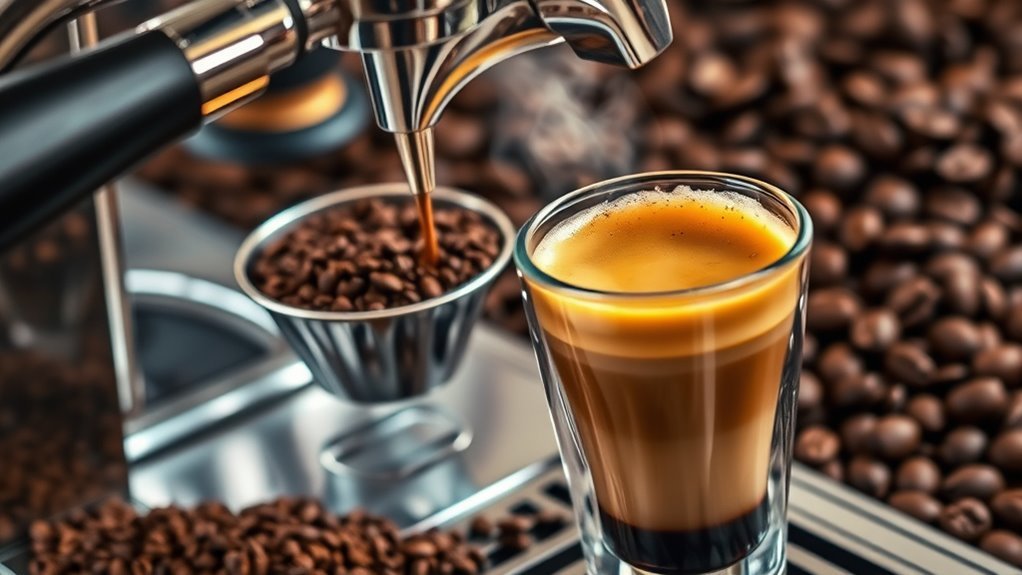
When using regular coffee in your espresso machine, understanding brewing techniques is crucial for ideal flavor. Pay close attention to grind size, as it greatly influences extraction efficiency, and make sure you maintain precise brew temperature for consistency. Finally, fine-tune your extraction time to achieve the desired balance between acidity and richness in your cup.
Grind Size Matters
Grind size plays an essential role in determining the quality of espresso, and using regular coffee in an espresso machine requires careful consideration of this factor. For ideal results, you’ll want to achieve the right grind consistency to manage brew pressure effectively. If the grind is too coarse, the water flows too quickly, leading to under-extraction. Conversely, a grind that’s too fine may cause over-extraction and bitterness.
- Feel the rush of a perfectly brewed shot.
- Savor the rich, complex flavors that come alive.
- Experience the liberation of crafting your own espresso.
Brew Temperature Control
Although many overlook it, brew temperature control is essential for extracting the full spectrum of flavors from your coffee, especially when using regular coffee in an espresso machine. The ideal extraction typically occurs between 195°F and 205°F. If you stray too far from this range, you risk under-extraction or over-extraction, both of which can lead to undesirable flavors. Here’s a quick reference:
| Brew Temperature (°F) | Extraction Quality | Flavor Profile |
|---|---|---|
| Below 195 | Under-extracted | Sour, weak taste |
| 195-205 | Ideal extraction | Balanced, rich flavor |
| Above 205 | Over-extracted | Bitter, harsh taste |
Extraction Time Optimization
To achieve ideal extraction in your espresso machine, it is crucial to pay attention to the extraction time, as this can greatly influence the final flavor and aroma of your coffee. Ideal extraction time enhances extraction efficiency and promotes brewing consistency, ensuring each cup meets your standards.
- A perfectly timed shot releases rich, complex flavors.
- Under-extraction leaves your coffee tasting sour and weak.
- Over-extraction results in bitterness that can ruin the experience.
Aim for a shot time between 25 to 30 seconds, adjusting grind size and tamping pressure to refine your process. This balance will not only elevate your coffee but also empower you to explore the full spectrum of flavors in each brew. Enjoy the freedom to experiment!
Flavor Profiles: What to Expect
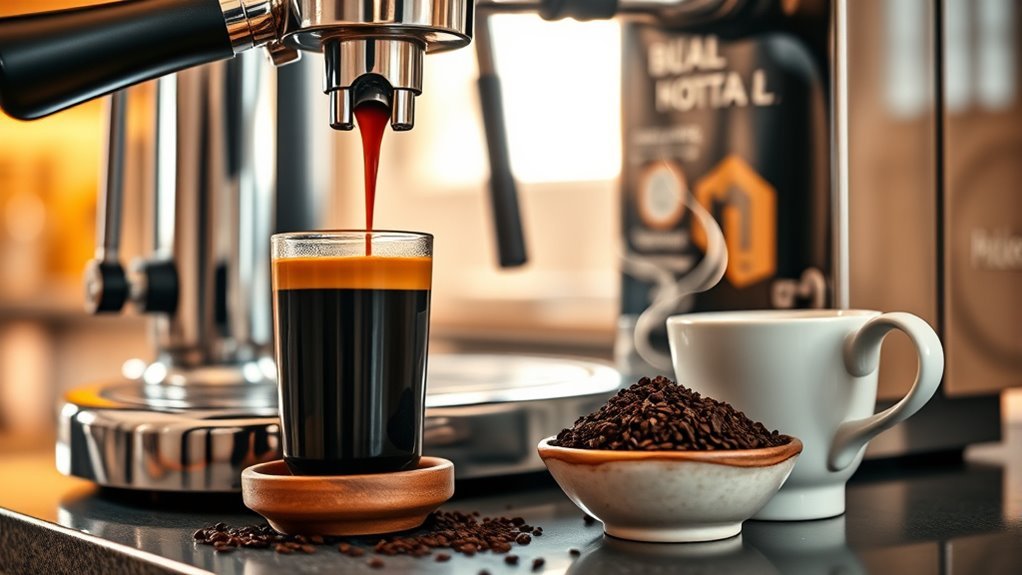
When using regular coffee in an espresso machine, you might be surprised by the flavor profiles that emerge. The flavor intensity can vary greatly compared to traditional espresso blends, often leaning towards a milder, more acidic taste. This is due to the differences in bean origin and roast level. You may notice that the taste balance shifts, with some coffees showcasing bright, fruity notes while others may present earthy undertones. The extraction process can accentuate these flavors, but it may not achieve the same depth as espresso specifically crafted for this brewing method. Ultimately, expect a unique coffee experience that, while different, can still be enjoyable and satisfying if you’re willing to embrace the unexpected.
Alternatives to Using Regular Coffee in Espresso Machines
If you’re looking for alternatives to regular coffee in your espresso machine, several options can enhance your coffee experience. Exploring different coffee bean types can lead to new flavor discoveries.
- Single-origin beans: These offer unique taste profiles tied to their region, providing a sense of adventure with every sip.
- Flavored coffee beans: With options like vanilla or hazelnut, these can add an exciting twist to your espresso shots.
- Alternative brewing methods: Consider experimenting with techniques like Aeropress or pour-over, which can yield rich, concentrated flavors similar to espresso.
Frequently Asked Questions
Can I Use Flavored Regular Coffee in an Espresso Machine?
Imagine savoring a cup of coffee that tantalizes your taste buds like a sweet melody. You might wonder if you can use flavored regular coffee in your espresso machine. While it’s technically possible, it’s not ideal. Flavored coffee can alter the espresso flavor, potentially leading to a less balanced shot. If you’re seeking that rich, authentic espresso experience, it’s better to stick with high-quality espresso beans. Your taste buds will thank you!
How Does Water Temperature Affect Regular Coffee in Espresso Machines?
Water temperature plays an essential role in brewing coffee with an espresso machine. If the brewing temperature’s too low, you won’t extract the full flavors, leading to a sour taste. Conversely, if it’s too high, you risk over-extraction, resulting in bitterness. Ideal extraction time is typically around 25-30 seconds, and maintaining the right temperature guarantees that you achieve a balanced flavor profile. So, adjusting these parameters can greatly enhance your coffee experience.
Will Using Regular Coffee Void My Espresso Machine Warranty?
Many believe using regular coffee might void their espresso machine warranty, but it’s not that straightforward. Warranty terms often focus on damage caused by improper use, not the type of coffee used. However, using low-quality coffee can affect the machine’s performance and longevity. If you care about maintaining coffee quality, it’s wise to stick to beans recommended for espresso. Always check your warranty documentation for specific clauses regarding coffee use to be safe.
Can I Make Espresso Drinks With Regular Coffee?
You can make espresso drinks with regular coffee, but the results may not meet your expectations. For ideal espresso extraction, you need a fine coffee grind, typically used for espresso. Regular coffee is often coarser, which can lead to under-extraction and a weaker flavor. If you enjoy experimenting, give it a try, but keep in mind that the taste might differ considerably from traditional espresso, limiting your freedom to savor the classic experience.
How Much Regular Coffee Should I Use in an Espresso Machine?
When using regular coffee in your espresso machine, it’s essential to take into account coffee grind size and brewing time. Typically, you’ll want about 18-20 grams of coffee for a double shot. Opt for a fine grind, similar to table salt, to guarantee proper extraction. Brew time should be around 25-30 seconds. This balance will help you achieve a richer flavor, allowing you to enjoy your espresso drinks without being restricted by traditional coffee options.
